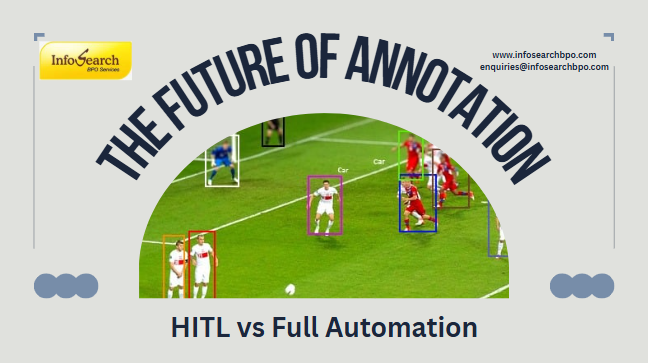Infosearch combines the human-in-the-loop annotation with automation to deliver the best annotation services. Both have their advantages, and when we combine them, we are able to provide better results. Contact Infosearch for your outsourced data annotation services.
The future of annotation will be discerned through an evaluation of Human-in-the-Loop (HITL) alongside Full Automation approaches regarding scalability and accuracy and their effects on artificial intelligence development.
What Is Human-in-the-Loop Annotation?
Through HITL annotation methods humans team up with AI systems or AI systems work together with humans for the data annotation process. People either approve or amend or expand the results which algorithms create.
The most suitable application of this approach covers intricate tasks together with difficult and subjective assignments.
Two common annotation tasks consist of medical image categorization and sentiment measurement as well as emotion identification on facial expressions
Advantages:
• The human evaluative process generates high accuracy because humans excel at noticing intricate aspects that algorithms sometimes fail to detect.
• People can detect training biases before correcting them to minimize false results.
• When humans offer corrections to AI outputs these corrections develop into better future performance for the machines.
What Is Fully Automated Annotation?
Automated full labeling functions through pre-trained AI models that operate without human supervision on data processes. Such processes benefit from automatic annotation due to their requirement of quantity and swiftness over pinpoint accuracy.
This method suits the labeling of simple objects along with boundary boxes and OCR tasks as well as speech-to-text functions.
AI models perform three types of annotation: Vehicle detection, barcode tagging, keyword extraction.
Advantages:
Fast and cost-efficient: Ideal for high-volume datasets
Data processing through this method becomes fast at the same time models train efficiently.
The system produces consistent results because human annotator variability is completely eliminated.
HITL vs Full Automation: A Comparison
Feature Human-in-the-Loop Full Automation
Accuracy High to moderate Depends on what tasks are performed
Scalability Moderate Very high
Speed Slower Extremely fast
Cost Higher Lower
The optimal applications for complex decision-making situations alongside unpredictable scenarios exist alongside repetitive tasks with high data volumes.
AI Training Impact Adds interpretability, feedback Requires fine-tuning for precision
The Emerging Trend: What’s in the Pipeline
Every strategic prediction points towards combining both systems to achieve the best results. The standard practice now involves AI-first pipelines that receive human oversight. Here’s how:
• AI systems initiate the first analysis process by performing either automatic labeling tasks or annotation suggestions.
• Humans check and improve detected outputs as part of the process.
• The process involves human supervision to integrate machine speed with cognitive ability and delivers results more quickly while maintaining high standards.
Key Sectors Leading the Way
• Through HITL testing autonomous vehicles maintain safety security for unpredictable human actions such as pedestrian or cyclist interferences.
• The medical field requires human involvement for the interpretation of X-rays together with the reading of MRIs as well as genomic information analysis.
• Entity matching in financial documents and legal paperwork needs periodic human input for correct interpretation.
• E-commerce & Retail solutions depend on automation on large scales and human intervention for precise product order identification.
Conclusion:
Augmentation Over Replacement
Future annotation systems will not replace human participation since they should combine human capabilities with machine strength for optimal operation.
Human-in-the-loop systems will maintain their essential role to guide and correct advanced automation together with their ability to enhance it while machine learning develops with both accuracy and accountability.
The most efficient annotation methods raise human capabilities instead of removing people from the process.








Recent Comments